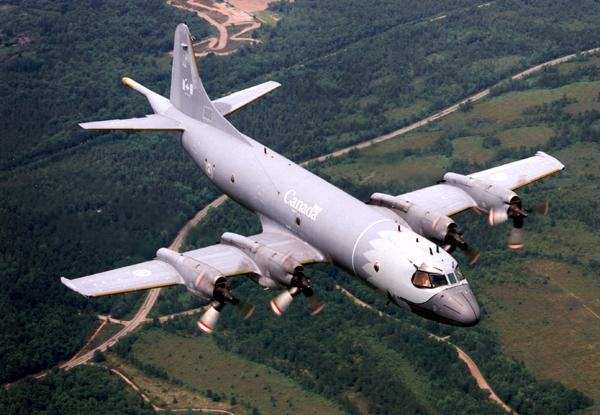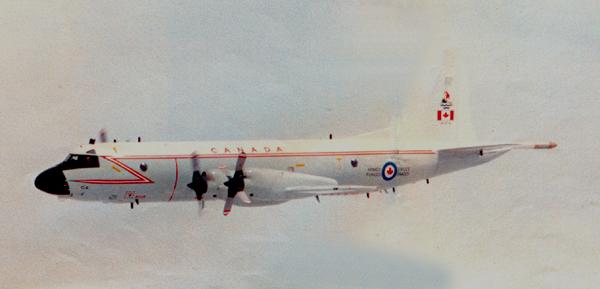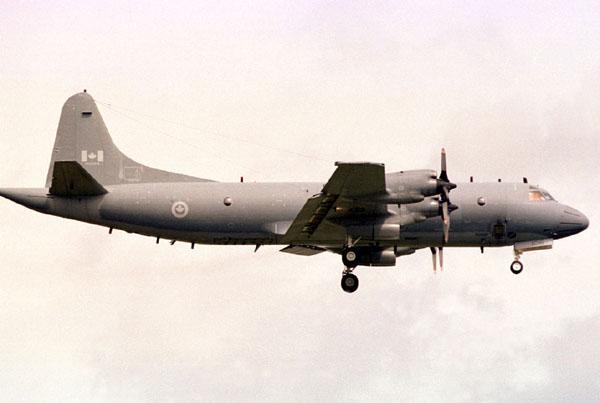The CP-140 Aurora is a four-engine long-range patrol aircraft
used for maritime surveillance on Canada's east and west coasts and throughout
the Arctic. Canada's Air Force began to receive the Aurora in 1980 from
Lockheed Martin and now operates a fleet of 18 aircraft (2010) . Thirteen
are stationed at 14 Wing Greenwood, Nova Scotia and five at 19 Wing Comox,
BC.
Although the Aurora is capable of carrying out a variety of operations,
its systems were based on 1960's technology. Its mission suite, for example,
did not meet the needs of modern non-combat, peace support or combat operations.
To address the problem , the $1B Aurora Incremental Modernization Project
AIMP) consisting of 21 sub-projects, is being implemented to restore the
Aurora's operational capability. Started in 1997, the program has now entered
its third and final phase.
Since the initial purchase of the Aurora, the Canadian Forces acquired
three additional CP-140 airframes. These three Aircraft have been designated
as the CP-140A "Arcturus". They do not include the ASW and tactical equipment
that the Aurora does. The CP-140A can carry and deploy two SKADs (Survival
Kit Air Dropable) and can carry weapons in the internal weapons bay. In
the latter case, however, this is only for transport purposes. There are
no underwing attachment points and the sonobuoy tubes are not wired for
use. The aircraft does have the tail boom extension but the associated
Magnetic Anomaly Detection (MAD) equipment is not fitted. Similarly, the
aircraft do not have the belly-mounted vertical camera system. The principle
visible external difference is the lack of the wingtip-mounted ESM equipment
fitted to the CP-140 aircraft. The CP-140As have four observer stations
with bubble windows and the auxiliary escape hatch behind the pilot's seat
has an optical window for handheld photography.
They are primarily used for pilot training but are capable of general
maritime reconnaissance on surface vessels (counter-drug operations, detecting
smuggling of illegal immigrants, fisheries protection patrols, pollution
monitoring, etc.), search-and-rescue assistance, and Arctic sovereignty
patrols. Three CP-140A aircraft – which were, in fact, the final three
P-3 Orion airframes manufactured on Lockheed's California-plant assembly
line – were ordered in 1991. One was phased out but two remain in service
in mid 2010. The Arcturus does possess a superior AN/APS-507 surface search
radar which incorporates modern functions such as track-while-scan that
the Aurora's AN/APS-506 radar lacks. The CP140A does however, maintain
the same military communications suite as the CP-140 Aurora.
CHARACTERISTICS
Length: 35.61 m (116.83 ft)
Wingspan: 30.37 m (99.6 ft)
Height: 10.30 m (34 ft)
Empty Weight: 27,892 kg (61,490 lbs)
Maximum Gross Weight: 64,410 kg (141,997 lbs)
Power: 4 x Alison T-56-A-14-LFE turboprop engines
Maximum Speed: 750 km/h (466 mph)
Cruising Speed: 648 km/h (403 mph)
Service Ceiling: 10,668 m (35,000 ft)
Endurance: 14 hours
Range: 9,266 km (5,000 nm)
Sensors: Radar; sonobuoys; forward-looking infrared (FLIR) camera;
magnetic anomaly detector (MAD); electronic support measures (ESM); fixed
70 mm camera; hand-held camera; night vision goggles; gyrostabilized binoculars.
Weapons System: Mark 46 Mod. V anti-submarine torpedoes; signal chargers;
smoke markers; illumination flares
(Can also be retrofitted to carry anti-ship air-to-surface missiles).
Bomb bay uses BRU-12A Weapon shackles; Bomb bay and wing stations
fitted with BRU-15A shackles.
Other Equipment: Two “Sea Survival Kit—Air-Droppable” (SKAD), and Arctic
SKAD units.
Crew Size: Mission minimum 8 personnel. Two pilots, one flight
engineer, four navigators and 3 airborne electronic sensor operators (AESOPs).
Crew size will vary according to the mission. Initially the crew which
handled non-acoustic sensors were known as NASO's (Non-Acoustic Sensor
Operators)
Quantity in CF: 18
Original cost: $24,905,000 each.
Stationed at 19 Wing Comox, BC and 14 Wing Greenwood, NS
THE FUTURE
Aurora Incremental Modernization Project (AIMP)
The Aurora Incremental Modernization Project, initiated in 1997 to upgrade
electronics of the Aurora fleet was halted by the government on 20 September
2007 to evaluate whether the aging fleet should continue to be upgraded
or replaced by more modern aircraft. Initially estimated at $1.6B,
project had been cut back but on 18 December 2007, the Department of National
Defence rescinded this work suspension and will continue with the modernization.
This includes upgrading computer, navigation, communication and radar systems
as well as making structural improvements to ten of eighteen aircraft.
The intent of the modernization project is to "keep the aircraft safe and
operationally viable until 2020.” Once each aircraft is completely
modernized, it will be assigned the CP-140M designation. Although the other
eight Auroras and two CP-140A Arcturus are to be retired, the ten
AIMP upgraded aircraft are to bridge the gap until Aurora replacements
arrive around 2015 or later.
AIMP is currently divided into three "blocks":
Block I is essentially complete (with only 1 a/c left to go in July
2010) and it concentrated on the replacement of unsupportable systems.
Block I configuration was a temporary state for all the aircraft as they
proceeded through Block II and perhaps Block III upgrades.
Block II brought a glass cockpit with the Navigation and Flight Instruments
(NFI) component and a complete replacement of the communications suite.
Block II is nearing completion and should be complete in early 2011.
Block III is a wholesale replacement of the aircraft's sensors and mission
computer.
Reference will be made to these blocks when describing upgrades in
the Electronics Suite document.
Captain Stephanie Hale expands on Block III. "One CP-140M Aurora has
completed AIMP Block III configuration. Currently located in Greenwood,
it is undergoing testing and evaluation. Block III completion was initially
the scheduled for August 2011, but this plan has slid a bit and work
is approximately one year behind initial plans.
Initial plans foresaw a fleet of ten CP-140M and eight CP-140 Block
II. This plan is now changing daily and we expect to see more of the Block
II planes upgraded to Block III (CP-140M). Currently the fleet's life has
been extended to approximately 2018-2020 (making them almost 40 years old);
however, plans are being considered to extend them beyond that (perhaps
as far as 2030 or beyond). In order to permit our life extension and to
address structural cracking and corrosion issues, Block III upgrades incorporates
SLEP (structural life extension project) which involves rewinging the planes
and replacing key structural components in the horizontal stabilizers".
Colonel Iain Huddleston is Commander of 14 Wing Greenwood, Nova Scotia.
He provides this update to the CP-140 modernization program dated July
15, 2015.
"AIMP was proposed in 1998 to upgrade the CP-140 through a series of
four incremental blocks, each involving the upgrade or replacement of specific
systems and sensors. Block 1 involved the replacement of a variety of legacy
equipment and sub-systems. Block 2 introduced a modern communications management
system, upgraded navigation equipment and a modern cockpit. In parallel
with Block 2 but considered separately, an electro-optical infrared camera
turret was installed underneath the nose of the aircraft. Block 3, the
current block, replaces the mission computer, the acoustics system, electronic
warfare system, magnetic anomaly detector and synthetic aperture radar,
providing operators with a modern display screen, touchpad and trackball
controls. This is the point at which the old CP-140 earns the ‘M’ for Modernized.
Block 4, which is in the design phase at the moment, will add a high-speed
beyond-line-of-sight communication system, a modern tactical data link
and an aircraft self-defense suite. To date, the LRP Force has received
half of the Block 3 modified airframes, with the remainder scheduled to
be modified over the next four to five years. The CP-140M Aurora is rapidly
being established as the pillar upon which Canada’s overall intelligence,
surveillance and reconnaissance system will be built."
More detailed information on the AIMP is available in the Electronics
Suite document which is selectab;le in the table below. .
Aurora Structural Life Extension Program (ASLEP)
The Aurora Structural Life Extension Project (ASLEP) is proceeding with
10 of the 18 Auroras scheduled to receive new wings and the replacement
of key structural components. On 18 November 2008, the Government of Canada
awarded a US$ 156 million contract to Lockheed Martin for 10 structural
life extension wing kits. The complete ASLEP solution replaces the aircraft's'
outer wings, center wing lower section and horizontal stabilizers with
new production components. All fatigue-life limiting structures on the
aircraft are replaced with enhanced-design components and improved corrosion-resistant
materials that will greatly reduce maintenance costs over the aircraft's
service life. This program is expected to extend the CP140s' service life
by 15,000 flight hours per airframe. Aging aircraft can develop unpredictable
faults, but if this effort is successful, it could extend the planes’ in-service
time by 15 years or more.
Arcturus (a/c 119) has been removed from service and is only used as
a technician trainer at this time. The other two CP-140A aircraft,
#120 and #121, are due to be retired by end of 2010. Although they are
the newest of the fleet in terms of years, these aircraft will retire with
approximately 40,000 landings. They have seen a great deal of use both
as pilot trainers and operationally.
Canada's Department of National Defence has announced that it
plans to replace the upgraded and 're-lifed' CP-140 Aurora fleet between
2015 and 2020 and the leading candidate for CP-140 replacement is the Boeing
P-8 Poseidon. Defence Construction Canada staffers are already comparing
measurements of CFB Greenwood's hangars and Boeing P-8A Poseidon
airframe to see what modifications will be required to accommodate this
front-runner for the CP-140M replacement.


